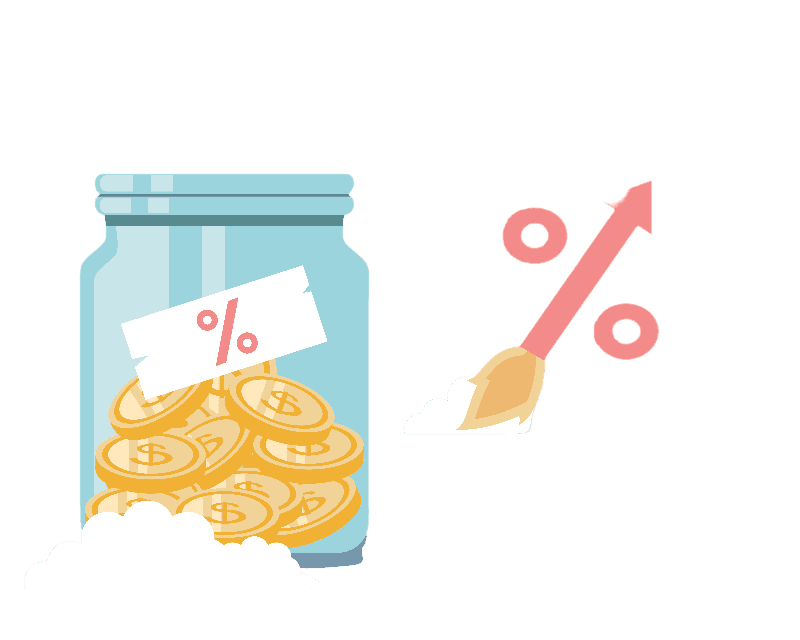
Crypto savings refers to the practice of using cryptocurrencies as a means of setting aside funds for the purpose of future growth, financial goals, and potential returns. It involves holding and storing digital assets in secure wallets, similar to traditional savings accounts, with the anticipation that the value of these assets may increase over time.
Importance Of Saving And Investing
Financial Planning: Saving and investing are essential components of achieving financial stability and long-term goals. By setting aside money today, individuals can create a safety net for unforeseen expenses and prepare for major life events.
Inflation Hedge: Traditional savings might be eroded by inflation over time, reducing their purchasing power. Crypto savings, on the other hand, provide an alternative store of value that isn’t directly tied to traditional financial systems.
Potential for Growth: Unlike traditional savings accounts with relatively low-interest rates, cryptocurrencies have shown the potential for significant price appreciation, offering the possibility of higher returns over time.
Diversification: Including cryptocurrencies in a diverse investment portfolio can mitigate risk. Cryptocurrencies often exhibit different market behavior compared to traditional assets like stocks and bonds.
Benefits Of Crypto Savings
A. Potential for High Returns
1. Historical Performance of Cryptocurrencies
Cryptocurrencies have demonstrated the potential for remarkable price growth over relatively short periods. For instance, Bitcoin, the first and most well-known cryptocurrency, has experienced significant appreciation since its inception in 2009. This historical performance has attracted the attention of investors seeking substantial returns.
2. Examples of Significant Price Appreciation
Numerous examples highlight the extraordinary price appreciation of certain cryptocurrencies. For instance, Ethereum’s price surged from a few dollars to over a thousand dollars within a short span, creating substantial wealth for early investors. Other altcoins, although inherently more volatile, have also experienced impressive price spikes, albeit with varying degrees of risk.
B. Diversification
1. Adding a New Asset Class to an Investment Portfolio
Cryptocurrencies introduce a unique asset class that is uncorrelated with traditional financial markets. By incorporating cryptocurrencies into an investment portfolio, individuals can diversify their holdings and potentially reduce overall risk exposure. This diversification can provide a buffer against the fluctuations of traditional assets.
2. Reducing Overall Investment Risk
Diversification across different asset classes, including cryptocurrencies, can help mitigate the impact of poor performance in any one area. If traditional markets experience a downturn, the potential gains from well-performing cryptocurrencies could counterbalance losses in other parts of the portfolio.
C. Accessibility and Global Reach
1. Anyone with an Internet Connection Can Participate
Unlike traditional financial systems, which often require extensive documentation and adherence to geographical restrictions, cryptocurrencies are accessible to anyone with an Internet connection. This inclusivity allows individuals from all walks of life to participate in the global financial ecosystem.
2. Overcoming Traditional Banking Barriers in Certain Regions
In regions with limited access to traditional banking services, cryptocurrencies provide an alternative means of storing and transferring value. This is particularly valuable in areas where banking infrastructure is underdeveloped, giving individuals greater control over their finances.
D. Control and Ownership
1. Self-Custody of Crypto Assets Using Wallets
Cryptocurrencies enable individuals to have direct control over their assets through the use of wallets. These wallets allow users to securely store their cryptocurrencies, manage their private keys, and transact directly without relying on third parties.
2. Elimination of Intermediaries Like Banks
Traditional financial transactions often involve intermediaries like banks, payment processors, and clearinghouses. Cryptocurrencies enable peer-to-peer transactions, reducing the need for intermediaries and potentially lowering associated fees and delays.

The benefits of crypto savings showcase the potential for substantial returns, enhanced diversification, increased accessibility, and greater control over one’s financial assets. However, it’s important to note that these benefits come with associated risks, including price volatility and security considerations. As with any investment, thorough research, risk assessment, and caution are advised.
How Crypto Savings Works
A. Choosing Cryptocurrencies
1. Researching Different Cryptocurrencies
Before starting crypto savings, it’s crucial to research and understand the various cryptocurrencies available. Each cryptocurrency serves a different purpose and operates on a distinct technology. Research can involve studying whitepapers, understanding the underlying blockchain technology, and assessing the credibility of the project and its team.
2. Assessing Their Use Cases, Technology, and Market Trends
Evaluate the practical applications of each cryptocurrency. Some may focus on digital payments, smart contracts, decentralized applications (DApps), or stores of value. Additionally, analyzes the technology behind the cryptocurrency, including its scalability, security, and consensus mechanism. Monitoring market trends and sentiment can help you gauge potential price movements.
B. Selecting a Wallet
1. Explanation of Different Types of Wallets
There are several types of wallets to choose from:
Hardware Wallets: Physical devices that store your cryptocurrencies offline, providing high security.
Software Wallets: Applications on your computer or mobile device for convenient access.
Paper Wallets: Physical paper containing your public and private keys, providing an offline storage option.
Online Wallets: Wallets hosted on the internet, accessible from various devices.
2. Emphasis on Security and Private Key Management
The private key is a critical component in controlling your cryptocurrency assets. It’s essential to keep it secure to prevent unauthorized access. Hardware wallets are known for their robust security, as they keep private keys offline. Software wallets should be protected with strong passwords and two-factor authentication. Paper wallets should be stored in a secure and fireproof location.
C. Making Deposits
1. Purchasing Cryptocurrencies from Exchanges
To begin your crypto savings, you’ll need to acquire cryptocurrencies. This is often done through cryptocurrency exchanges, which are online platforms where you can buy, sell, and trade various cryptocurrencies using traditional currencies like USD, EUR, etc. Ensure that the exchange you choose is reputable and follows security practices.
2. Transferring Funds to the Chosen Wallet Address
Once you’ve purchased cryptocurrencies on an exchange, it’s recommended to transfer them to your chosen wallet for greater security. Each wallet has a unique address where you can receive funds. This transfer ensures that you have full control over your assets and minimizes the risk of exchange-related issues, such as hacks or closures.

By following these steps, you establish a foundation for your crypto savings strategy. Remember that the security of your private keys and the chosen wallet is paramount. Regularly updating your knowledge about the cryptocurrencies you’re holding and their associated technologies will help you make informed decisions regarding your savings.
Strategies For Crypto Savings
A. Long-Term Holding (HODLing)
1. Holding Assets for Potential Long-Term Appreciation
Long-term holding, often humorously referred to as “HODLing” in the crypto community, involves purchasing cryptocurrencies with the intention of keeping them for an extended period. This strategy is based on the belief that the value of these assets will increase significantly over time, leading to potential substantial returns.
2. Importance of Patience and Avoiding Emotional Trading
Successful long-term holding requires patience and the ability to withstand short-term price volatility. Emotional reactions to price fluctuations can lead to impulsive decisions, such as panic selling during market downturns. Investors who practice HODLing typically have strong conviction in the long-term potential of their chosen cryptocurrencies.
B. Staking
1. Explanation of Proof-of-Stake Consensus and Staking Rewards
Proof-of-stake (PoS) is a consensus mechanism used by certain cryptocurrencies to secure the network and validate transactions. In PoS, instead of mining, participants lock up a certain amount of the cryptocurrency as collateral, essentially “staking” it. Stakers are then chosen to create new blocks and validate transactions based on the amount of cryptocurrency they hold and are willing to “stake” as collateral.
2. Earning Passive Income by Participating in Network Validation
Staking allows individuals to earn rewards in the form of additional cryptocurrency by participating in network validation. The more cryptocurrency you stake, the higher your chances of being chosen to validate transactions and receive rewards. This can be a way to earn a passive income while also contributing to the security and efficiency of the blockchain network.
C. Yield Farming and Liquidity Providing
1. Participating in Decentralized Finance (DeFi) Protocols
Decentralized Finance (DeFi) refers to financial applications built on blockchain networks that aim to replicate traditional financial services in a more open and permissionless manner. Yield farming involves providing liquidity to DeFi protocols by lending your cryptocurrencies to others in exchange for interest or rewards.
2. Earning Interest or Rewards by Lending Assets or Providing Liquidity
By participating in yield farming or liquidity providing, individuals can earn interest or rewards for supplying their cryptocurrencies to DeFi platforms. These rewards may come in the form of additional tokens or a percentage of the transaction fees generated on the platform. However, this strategy comes with risks, including smart contract vulnerabilities and impermanent loss.
These strategies offer various ways to grow your crypto savings. Each approach has its own risk profile and potential rewards, so it’s essential to thoroughly research and understand the mechanisms before implementing any strategy. Crypto investments come with inherent volatility and risk, so it’s wise to diversify your strategies and exercise caution.
Tips For Successful Crypto Savings
Cryptocurrency markets can be highly volatile, with prices influenced by news, social media, and speculation. Avoid making impulsive decisions driven by FOMO (fear of missing out) or hype. Conduct thorough research before making any investment, and be wary of projects that promise guaranteed returns without solid foundations.
Diversification is a fundamental principle in investment. Spread your investments across various cryptocurrencies and other asset classes to reduce the impact of poor performance in any single asset. This can help mitigate risk and provide a more balanced portfolio.
Keep track of your portfolio’s performance and the broader market trends. Regularly assess how your chosen assets are performing and whether they align with your goals. This monitoring helps you identify any significant changes or shifts in the market.
Remember that successful crypto savings require a combination of knowledge, discipline, and careful decision-making. While the potential for growth exists, it’s essential to approach the market with a realistic outlook and a long-term perspective. As with any form of investment, risk assessment and proper planning are key to achieving your financial objectives.